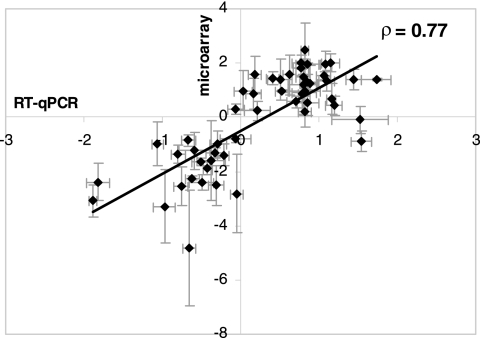The iron stimulon of Xylella fastidiosa includes genes for type IV pilus and colicin V-like bacteriocins.
Xylella fastidiosa is the etiologic agent of a wide range of plant diseases, including citrus variegated chlorosis (CVC), a major threat to citrus industry. The genomes of several strains of this phytopathogen were completely sequenced, enabling large-scale functional studies. DNA microarrays representing 2,608 (91.6%) coding sequences (CDS) of X. fastidiosa CVC strain 9a5c were used to investigate transcript levels during growth with different iron availabilities. When treated with the iron chelator 2,2'-dipyridyl, 193 CDS were considered up-regulated and 216 were considered down-regulated. Upon incubation with 100 microM ferric pyrophosphate, 218 and 256 CDS were considered up- and down-regulated, respectively. Differential expression for a subset of 44 CDS was further evaluated by reverse transcription-quantitative PCR. Several CDS involved with regulatory functions, pathogenicity, and cell structure were modulated under both conditions assayed, suggesting that major changes in cell architecture and metabolism occur when X. fastidiosa cells are exposed to extreme variations in iron concentration. Interestingly, the modulated CDS include those related to colicin V-like bacteriocin synthesis and secretion and to functions of pili/fimbriae. We also investigated the contribution of the ferric uptake regulator Fur to the iron stimulon of X. fastidiosa. The promoter regions of the strain 9a5c genome were screened for putative Fur boxes, and candidates were analyzed by electrophoretic mobility shift assays. Taken together, our data support the hypothesis that Fur is not solely responsible for the modulation of the iron stimulon of X. fastidiosa, and they present novel evidence for iron regulation of pathogenicity determinants.
Authors
Paulo A Zaini; Andréa C Fogaça; Fernanda G N Lupo; Helder I Nakaya; Ricardo Z N Vêncio; Aline M da Silva
External link
Publication Year
Publication Journal
Associeted Project
Life Sciences
Lista de serviços
-
Gene regulatory and signaling networks exhibit distinct topological distributions of motifs.Gene regulatory and signaling networks exhibit distinct topological distributions of motifs.
-
Gene signatures of autopsy lungs from obese patients with COVID-19.Gene signatures of autopsy lungs from obese patients with COVID-19.
-
Network Medicine: Methods and ApplicationsNetwork Medicine: Methods and Applications
-
ACE2 Expression Is Increased in the Lungs of Patients With Comorbidities Associated With Severe COVID-19.ACE2 Expression Is Increased in the Lungs of Patients With Comorbidities Associated With Severe COVID-19.
-
Drug repositioning for psychiatric and neurological disorders through a network medicine approach.Drug repositioning for psychiatric and neurological disorders through a network medicine approach.
-
Linking proteomic alterations in schizophrenia hippocampus to NMDAr hypofunction in human neurons and oligodendrocytes.Linking proteomic alterations in schizophrenia hippocampus to NMDAr hypofunction in human neurons and oligodendrocytes.
-
In-depth analysis of laboratory parameters reveals the interplay between sex, age, and systemic inflammation in individuals with COVID-19.In-depth analysis of laboratory parameters reveals the interplay between sex, age, and systemic inflammation in individuals with COVID-19.
-
The evolution of knowledge on genes associated with human diseasesThe evolution of knowledge on genes associated with human diseases
-
Network vaccinology.Network vaccinology.
-
Pyruvate kinase M2 mediates IL-17 signaling in keratinocytes driving psoriatic skin inflammationPyruvate kinase M2 mediates IL-17 signaling in keratinocytes driving psoriatic skin inflammation
-
Transcriptome analysis of six tissues obtained post-mortem from sepsis patientsTranscriptome analysis of six tissues obtained post-mortem from sepsis patients
-
Gene Signatures of Symptomatic and Asymptomatic Clinical-Immunological Profiles of Human Infection by Leishmania (L.) chagasi in Amazonian BrazilGene Signatures of Symptomatic and Asymptomatic Clinical-Immunological Profiles of Human Infection by Leishmania (L.) chagasi in Amazonian Brazil
-
In vitro morphological profiling of T cells predicts clinical response to natalizumab therapy in patients with multiple sclerosis.In vitro morphological profiling of T cells predicts clinical response to natalizumab therapy in patients with multiple sclerosis.
-
Integrative immunology identified interferome signatures in uveitis and systemic disease-associated uveitis.Integrative immunology identified interferome signatures in uveitis and systemic disease-associated uveitis.
-
Gene regulatory networks analysis for the discovery of prognostic genes in gliomas.Gene regulatory networks analysis for the discovery of prognostic genes in gliomas.
-
Revealing shared molecular drivers of brain metastases from distinct primary tumors.Revealing shared molecular drivers of brain metastases from distinct primary tumors.

